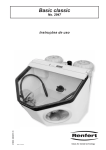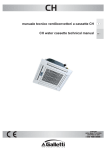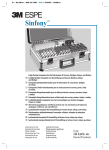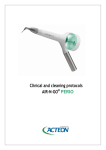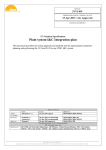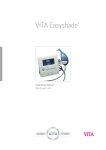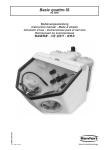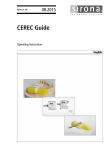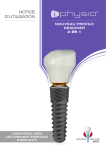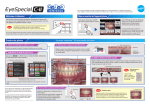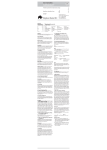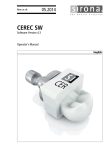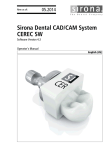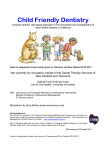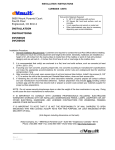Download Instructions of use innoBlanc® occlusal Nano‐glass‐ceramic
Transcript
Instructions of use innoBlanc® occlusal Nano‐glass‐ceramic composite for the CAD/CAM technology TEAMZIEREIS GmbH Gewerbepark 11 D‐75331 Engelsbrand Tel.: +49 (0) 7082 – 792670 Fax: +49 (0) 7082 – 792685 E‐Mail: [email protected] 1. General product specification innoBlanc® occlusal is a nano‐glass ceramic composite used in CAD/CAM technology for the production of permanent restorations which will be fixed with adhesive composite cements. Base is an industrial, high‐meshed thermoplastic acrylic polymer. innoBlanc® occlusal has considerably higher strength values than classical glass‐ or feldspar‐ceramics http, only granulated, medically tested PMMA raw material which is polymerized in a special process and which has no toxic or allergic accessories is used. The material is processed in an industrial injection molding under highest quality control. For the colouration, colour pigments with FDA (Food and Drug Administration/USA) license are used Available measures Strength of the disc 15mm / 20mm / 30mm Available colours Bright (Bleach) A2 A3 A3,5 C2 Note: There can be a difference between the colours of the manufactured restorations and the recommended reference colours of the recommended Vitapan colour ring due to different geometries and volumes of the objects. 2. Material composition ‐ ‐ Highly meshed, highly polimerisated resin nano glass‐ceramic composite with nano particles, inorganic glass fillers, embedded into a polymer matrix Colour pigments innoBlanc® occlusal is a special composite which is built up on the basis of acrylic‐polymers and a matrix of biological non‐hazardous acrylic resins. innoBlanc® occlusal contains no base monomers from the group up to –GMA (absence of Bisphenole A) and UDMA. The material is free of Dibutyl Phtalates (diluents). As filling materials only high purity, synthetic, biocompatible glasses are used. innoBlanc® occlusal contains no light‐ or UV sensitive initiators. 3. Way of production 4. Indications and application duration innoBlanc® occlusal discs are produced in special methods which are controlled according to DIN EN ISO 9001. The products are certified according to the regulation DIN EN ISO 13485 ‐ appendix II for medical products by TEAMZIEREIS GmbH. Indication: Inlay, onlays, chips, veneers, table tops, monolithic crowns (parodontal and as implant) telescopic primary parts (in connection with PEEK secondary parts, e.g. innoBlanc® medical PEEK) post & core, 3‐unit anterior bridges (in case of sufficient dimension if the connectors and an adhesive fixation) In general, the indications and application duration depends on the patient, the therapy plan, the geometry of the construction and the way of cementation. Regularly, the nano glass‐ceramic composite materials are more brittle than thermoplastic materials. The abrasion stability is clearly higher in comparison with thermoplasts. Due to the not jet sufficient clinical experiences, we consider the following indications to be contra-indicated for a permanent restoration: ‐ Bridges in the posterior area ‐ Bridges in the anterior area with more than one pontic ‐ Brackets and bracket model casts ‐ Transversal ribbons or sublingual brackets ‐ Bars Revision level: 3/ 2.4.2015 1 5. Design of the construction In general Nano glass‐ceramic composite materials are hard and more brittle than thermoplasts. Therefore, for the preparation and construction take into consideration that you have sufficient connector strengths, crown wall thicknesses and an optimal friction of the pillar crowns. (See also preparation and cementing). Design for veneering In principle, veneering is possible. Anyway, we recommend you to take the following construction characteristics into consideration: ‐ If possible, mill‐in retention pearls or scoring structure (“rice terrace design”). ‐ If possible, apply a thin, labial or circular shoulder (1mm). ‐ Ideally suited is a complete veneering according to the multilayer design (press‐on method in flask technology, gluing structures (digital veneering) in split file technique e.g. with a composite split file). ‐ No antagonistic contacts in the transition zone frame/veneer (See also individualization/veneering) Recommended geometries for the various indications Note: Exhaust the height for the construction of a connector or the occlusal and vestibular material strengths to the highest possible measure in case of permanent restorations! Minimum strength vestibular/crowns centrical/dynamic occlusion/inlay centrical/dynamic occlusion/full crowns anterior/3‐unit bridge Veneer at the incisal margin area 1‐1,5mm Minimum strength 1,5‐2mm Minimum strength 1,2‐1,5mm Connector cross section 12‐15mm Veneer labial 0,4‐0,6mm 0,5‐1,5mm in deviation 6. Preparation A CAD/CAM compatible preparation is significantly responsible for the exact fit and the duration of the restoration milled in innoBlanc® occlusal. The smallest milling and grinding units for dental milling strategies have a diameter of mostly 1,0mm, rarely of 0,5mm. Sharp edges (a diamond/miller cannot completely mill or grind them out) and preparation forms that generate extremely thin material strengths (< 0,2mm) of the milled object have to be avoided. Inlay and Onlay Classical inlay/only design for full ceramic constructions. No undercuts, cavity walls in conical angle of 5‐6° to the tooth axis, no sharp edges, approximal 90° preparation angle, ideally suited are incisal and occlusal retentions of 1,5‐2mm. Full Crown Shoulder preparation without taper or chamfer preparation, rounded incisal edges, sharp, remove narrow chimneys at the protuberance top, smooth surface of the preparation Veneer Labial reduction 0,4‐0,6mm, incisal (from labial to lingual) 0,5‐1,5mm, preparation margin supra‐gingival with chamfer or rounded shoulder, let the Preparation margin end in the dentine. 7. Manual processing – recommended tools and materials We recommend to use cross‐linked hard metal millers or green diamonds for rough treatments. For the fine or very fine preparation use cross‐linked hard metal millers or red, yellow, white diamonds. For the preparation of the high gloss polish polishing pasts for composite or ZrO2, diamond polishing paste with fine grain (sparingly applied). Robinson brushes of different temper, nettle, leather buffles, medium rotation speed 6000‐12000 turns per minute, medium to small grinding pressure. Intra-oral grinding corrections innoBlanc® occlusal has very good self‐grinding characteristics. However, we recommend to grind the grinded areas with yellow ring diamonds, finishing with white ring diamonds (8µm) and then to dense with brushes (soft) and diamond polishing pasts and/or composite rubbers. CAD/CAM Milling Instruments innoBlanc® occlusal can either be treated milled (hard metal milling units) or grinded (diamonds). innoBlanc® occlusal can be partially thinned up to 0,2‐0,3mm without chippings if you use a milling strategy appropriate for the material. Note: All nano glass‐ceramic composite materials are abrasive against hard metal millers. Obtuse millers affect the fit and generate a higher Revision level: 3/ 2.4.2015 2 temperature Infiltration into the material. A just in time change of the used millers is therefore absolutely recommended. According to the milling strategy, this can cause a higher waste of milling instruments in comparison with other polymer materials. 8. Completion with other Materials / Surface conditioning innoBlanc® occlusal can be completed with other methacrylate‐based, light‐hardening composites or combined with PMMA materials and composite glues (e.g. finishings, post&core parts). Preparations of the surfaces Note: Industrially highly meshed and highly polymerized hybrid materials have a hard, dense surface. The structure is compact. The preparation of the surface by roughening, blasting and bondering is necessary. Extra-oral Conditioning ‐ Blast the surface carefully with aluminum oxide, 50µm at 2.5 bar pressure or rough it with coarse stones or diamonds ‐ Clean and degrease the areas to be treated with q‐tips and acetone (no insertion) ‐ Conditioning with bonder (e.g. Rocatec (3 MEspe), Visio Link (Bredent) CRB Bond (Shofu)). 9. Intra-oral Conditioning ‐ Rough the surface carefully with coarse stones or with intra‐oral sandblast‐systems (e.g. Co‐Jet). ‐ Water‐flushing, cleaning and well drying ‐ Apply adhesive / bonding for intra‐oral applications. Veneering Classical Veneering We recommend to use resins which have similar or identical characteristics as innoBlanc® occlusal with regard to the surface glaze, the abrasive nature and the modulus of elasticity. In case you use veneering materials with a clearly different glaze grade, we recommend a complete covering of the labial area up to the marginal area of the restoration to avoid visibly transitions at the glaze level. Multilayer Technology innoBlanc® occlusal is excellently suited for constructions in multilayer technique or according to the principle of change‐able macro‐ retentive interconnection crowns (University of Munich) 10. Individualization and plaque vulnerability Full anatomical frames made of innoBlanc® occlusal can be individualized with corresponding light‐hardening painting colours and composites /lacquers according to the instructions of the manufacturer (e.g. Lite Art/company Shofu). Note: Light hardening colours for the individualization or light hardening varnishes increase the risk of a plaque settlement. The best protection against plaque vulnerability and superficial discolorations of occlusal is a homogeneous, by polishing compressed surface of the pure basic material. 11. Extra oral agglutination (e.g. post & core, components in the multilayers' technology) Preparation of innoBlanc® occlusal See item 8 completion with other materials / surface conditioning Preparation of zirconium dioxide frames in case of multilayer technology ‐ Blast the surface carefully with aluminum oxide, 50 µm at 1‐1.5 bar pressure ‐ Degrease with acetone or ethyl acetate (one‐time brush, q‐tip). Ventilate well. ‐ Silanization/apply primer (e.g. Monobond plus (Ivoclar), Alloy Primer (Panavia/Kuraray), Metal Primer (GC) or similar products. Preparation of adhesive build‐ups made of titanium ‐ Blast the surface careful with aluminum oxide, 50 µm at 2.5 bar pressure ‐ Degrease with acetone or ethyl acetate (one‐time brush, q‐tip). Ventilate well. ‐ Silanization/apply primer (e.g. Monobond plus (Ivoclar), Alloy Primer (Panavia/Kuraray), Metal Primer (GC) or similar products. Use and preparation of glues We recommend the use of a self‐adhesive, dual hardening composite glue for dental need. Please follow the instructions of the manufacturer (e.g. Panavia 2.0 (Kuraray), multi‐link Implant (Ivoclar), Rely X Unicem (3 M Espe), Vario link (Ivoclar) and others) or use suitable adhesives for prosthetic applications. Note: We recommend to preheat the gluing material at approx. 50° C before use. This causes to a better viscosity (easier, gap‐free assembling) and increases the polymerization degree. Revision level: 3/ 2.4.2015 3 In case you glue parts with adjustment spools (e.g. sticking post) we recommend marking the abutment with a pen to insure a safe positioning. Lock screw holes with wax. 12. Cementing Provisional Industrial highly‐meshed and highly polymerized hybrid materials have a hard, dense surface. The structure is compact. The preparation of the surface by roughing, blasting and bondering is necessary (also see point 8). Provisional cements involve the danger of de‐cementing or loosening of the restoration which results in a higher risk of fracture. Try-in of the milled parts Nano glass‐ceramic composite materials are hard and brittle. The try‐in of the milled restorations has to be done very carefully and with very less pressure, especially if there are very thin margins. Otherwise it can cause chippings like in case of ceramics. Provisional: Provisionals have to be inserted with non‐eugenol cements. Otherwise, the later necessary, adhesive fixation cement does not generate a real adhesion with the tooth substance. Permanent Inner areas of the crowns or the areas to be fixed have to be blasted with aluminum oxide, 50 µm at a pressure of 2,5 bar and then be cleaned with alcohol and dried. Etching with hydrofluoric acid is not necessary. For the permanent fixation of innoBlanc® occlusal you have to use an adhesive or self‐adhesive cement (e.g. Panavia 2.0 (Kuraray), Multiling Implant (Ivoclar), Rely X Unicem (3M Espe) Vario Link (Ivoclar) or similar products). 13. Chemical Duration/Cleaning and Sterilization Steam Cleaning At normal exposure, innoBlanc® occlusal is sufficiently resistant against deformation at steam cleaning and can be sterilized with the methods used for composite materials. Consistancy innoBlanc® occlusal is chemically resistant against thin acids, bases, water, grease and oil. Fixed Denture After a professional cleaning, e.g. with air flow, it is necessary that the surfaces are polished to high‐glaze again to avoid plaque attachments and discolourations of the surface. 14. Storage/store conditions Ideal storage temperature No extreme temperatures, optimal are 15 ‐ 20 ° Celsius. 10 ‐40 ° Celsius is unproblematic. Environment Dry, no humidity, no high air dampness, storage in the inside area. Resistance and contamination Contact with other substances, as e.g. with oils, greases or solvents, has to be avoided. Maximum durability of the disc without loss of the material qualities at the store conditions given above: 5 years. 15. Disposal The product and final products made of it can be disposed of over the domestic rubbish, but please follow the regulations of the appropriate authority and the disposal company. 16. Final remarks All details are based on our own experiences and of details out of the literature which we have listed in the clinical assessment. The statements and recommendations made do not lay any claim to completeness. We reserve the right to change these instructions of use. Revision level: 3/ 2.4.2015 4







